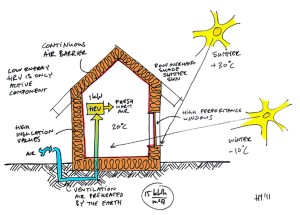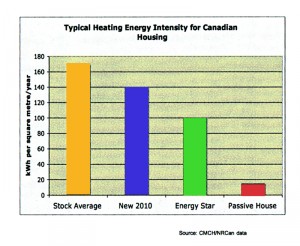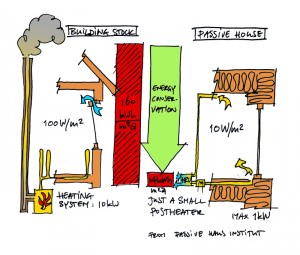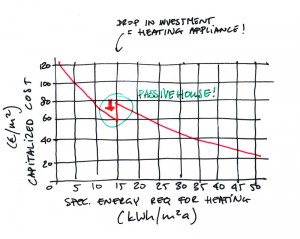Passive House is a building concept that is very energy-efficient, requiring such a small amount of heat that it can be heated by mainly passive heat sources, such as incoming sunlight, household appliances and inhabitants.
A HRV (Heat Recovery Ventilation) system is a necessary, and the only active component of the system. Depending on the climate, a small post heater is needed to heat the incoming air to a comfortable temperature.

Passive House reduces the required energy to heat a building by:
- smart design
- increasing thermal insulation
- air tightening the building envelope
- installing high performance windows
- incorporating an HRV system.
Due to the extreme air tightness (a minimum requirement of 0.6 air changes per hour at a pressure of 50Pa) a mechanical ventilation system with an HRV (Heat recovery Ventilation) is needed to supply fresh air. The HRV pre-heats the cold incoming air with the warm exhaust air through a heat exchanger, reducing the heat loss through ventilation.
The energy required for the HRV is often so low, that it can be economically and feasibly supplied by renewable energy source such as a PV panel.

This graph from the Canadian Passive House Institute shows the average energy requirement for space heat of Canadian homes. The Canadian average housing stock uses 170 kwh/m2a, while a new (to code) house uses 140 kwH/m2a and an ‘Energy Star’ uses 100 kWh/m2a. A Passive House uses only 15kWh/m2a!
Imagine!
Say, if you were to live here in Kaslo, where it is common to burn wood to heat your home, in an average 1500 sq.ft. house, you would probably burn about 3 cords of wood each year. If your home were to be a Passive House, you would only need 1/3 cord of wood each year!

The Passive House concept contrasts with the widespread idea that one can create a low or net-zero energy home by incorporating active —and often expensive— renewable energy technologies such as PV, solar hot-water panels, geo-thermal heating, micro-hydro, etc.
With Passive House extreme energy savings can be enjoyed with a minimal investment.

The graph below shows that the capitalized cost (of incorporating energy reducing solutions, i.e. insulation) increases as the specific energy requirement for heating decreases.
At 15 kWh/m2a there is drop in investment, with the same amount of energy requirement. This drop in capitalized cost represents the cost of a furnace. This is the critical point where the investment in energy reduction has its greatest effect and therefore this value of 15kWh/m2a has been determined to be the minimum requirement for Passive House standard.
Incorporating the Passive House concept into our built environment will enable us to do our part —as builders, home-owners and design professionals— for the reduction of greenhouse gasses in the atmosphere.
Passive House is the ideal concept to help us achieve net-zero energy buildings.

